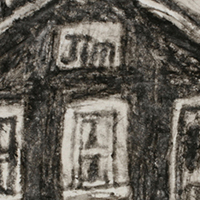James Castle 1899-1977 Profoundly Deaf USA Artist
James Castle was born September 25, 1899, in the small mountain town of Garden Valley, Idaho to Francis J. Castle and Mary Nora Scanlon. The fifth of seven children, Castle was born two months premature. His mother was the local midwife and his father was the postmaster and ran the community post office and general store from the living room of the family home.
Castle was profoundly deaf from birth and did not attend school until he was ten years old, when he was enrolled at the Gooding School for the Deaf and Blind in southeastern Idaho. Castle attended and lived at the school for five years, from 1910-1915.
While at the school, Castle was taught the oral method of communication—sign language was not taught in the public schools at the time—but it is likely he learned sign from the other students who secretly taught each other. Evident in his artwork are various references to specific signs. It is unknown to what extent Castle could read, though his artwork does demonstrate a fascination with written language. Any practical method of communication Castle may have learned at school was lost over the years because it was not practiced at home by his family.
With the exception of his tenure at the Gooding School, Castle resided in only three homes in Idaho: in the small town of Star, and on subsistence farms in Garden Valley and Boise. When Castle’s mother died in the 1930s, his sister Agnes inherited the family farm in Boise where Castle continued to live with his sister, brother-in-law and their four children in the small three-bedroom house.
Image > soot and spit on found paper
Art Practice
At a very early age Castle began drawing and making things with found materials. Throughout Castle’s lifetime, nearly everything that crossed his path inspired or influenced him. His daily ritual included checking all the trash containers in the home and throughout the immediate neighborhood. His discoveries became the materials from which he made his art, as well as fodder for his voracious visual memory. Depending entirely on his ingenuity, Castle fashioned materials such as sticks, apricot pits and broken fountain-pen nibs into tools he could use to create. He discovered he could scrape soot from the wood-burning stove and spit into the powdery substance to mix a black ink suited for his diverse imagery. He often derived color by squeezing pigment from saturated crepe paper. Family members gave him store-bought art materials such as oil sticks and watercolors, and he incorporated these new materials into his own self-made concoctions to produce the many subtle textures and colors found in his work.
Image > soot with artist tools
Recognition
In the 1950s, Castle’s nephew, Bob Beach, came home on a break from the Museum Art School in Portland, Oregon. Beach suggested to family members that Castle’s drawings, handmade books and constructions could be called “art.” Beach was allowed to take some of his uncle’s drawings back to the Portland art school to show his professors. This introduction launched the beginning of Castle’s recognition as an artist in regional museums and art galleries. Castle’s work quickly became the subject of one-person and group exhibitions throughout the Pacific Northwest from the 1960s until his death in 1977. Overwhelmed by the continued interest in his work, his family denied access to the collection for the next twenty years.
In 1998, Castle’s work was again introduced to the public at the Outsider Art Fair in New York City. Museum and gallery exhibitions soon followed throughout the US. Major museums acquired Castle’s work for their permanent collections, and the Philadelphia Museum of Art opened James Castle: A Retrospective in 2008. The 2013 Venice Biennale included eleven works by Castle in the feature exhibition The Encyclopedic Palace.
Artwork
James Castle explored a myriad of concepts and ideas within his work during an art practice that spanned nearly 70 years. Featured in this gallery is a selection of the many genres included in his oeuvre.
Doors and Windows
Grids
Houses 
http://jamescastle.com/ Copyright







